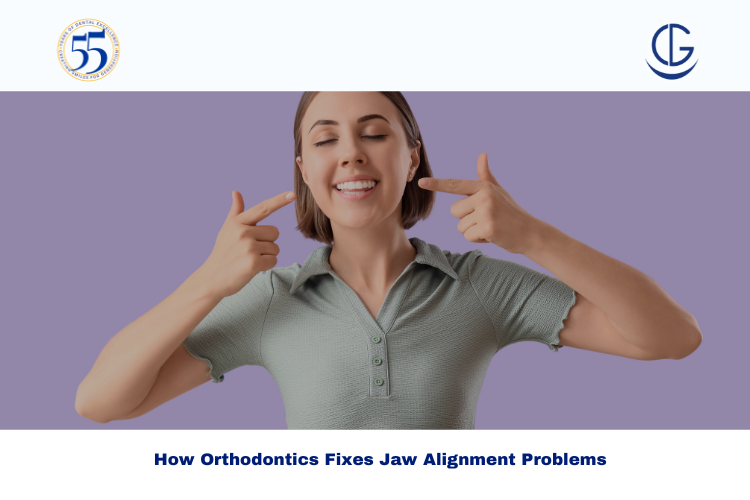Schedule Appointment




At Dr Gowds Dental Hospital in Hyderabad, the topic of jaw alignment comes up frequently as patients aim for both a comfortable bite and an attractive smile. In this blog post we’ll explore how orthodontics can improve jaw alignment, what causes jaw misalignment, how treatment with jaw alignment braces works, when orthodontic surgery may be needed, and importantly the risks you need to know.
Jaw alignment refers to the proper positioning of your upper and lower jaws so that they fit together in a functional and comfortable way. When alignment is correct, we can chew, speak and smile without pain or difficulty. But when the alignment is off, you’re dealing with what’s known as jaw misalignment.
There are several common causes of jaw misalignment:
When jaw misalignment is present, you might notice symptoms like frequent jaw pain, clicking or popping when you open your mouth, difficulty chewing, headaches, or even sleep-apnoea issues in severe cases.
An experienced orthodontist can assess jaw alignment problems and determine the best path forward. Here’s how orthodontic treatment is used to improve jaw alignment:
These are non-surgical treatments aimed at repositioning teeth — and when used correctly, they can influence jaw alignment too. At Dr Gowds Dental Hospital, braces and clear aligners are used often to adjust the bite so that the jaws fit together properly. With jaw alignment braces, minor misalignments can be corrected over months to years depending on the case.
In growing children, functional appliances (special devices) can guide the development of the jaws so that alignment improves naturally as they grow.
Since the jaws are still growing in teenagers, monitoring and early intervention can prevent a small misalignment from becoming a big problem later.
In cases of severe jaw misalignment — when the jaws are extremely out of alignment, or there’s a skeletal discrepancy — corrective orthodontic surgery may be required. This is often done in conjunction with an orthodontist and an oral/ maxillofacial surgeon. The goal is to reposition the jaws, correct bite, improve function, and enhance facial aesthetics.
Fixing jaw alignment brings several benefits:
In short: proper jaw alignment helps both health and confidence.
While orthodontic and surgical treatments are highly effective, there are risks and considerations you should be aware of:
Because jaw misalignment often progresses over time, delaying evaluation by an orthodontist can mean more invasive treatment later. For the best outcome, it’s wise to consult a professional early — especially if you see symptoms such as persistent jaw pain, difficulty chewing, or an asymmetric face.
If you’re in Hyderabad and concerned about your jaw alignment, here’s a typical path:
Reach out to an orthodontist if you observe any of the following:
A good orthodontist will assess your jaw alignment carefully and guide you to the best solution.
Improving jaw alignment through orthodontics can resolve functional problems, reduce pain, improve your smile and support long-term dental health. Whether it’s through jaw alignment braces or in more complex cases orthodontic surgery, the key is timely, professional intervention. At Dr Gowds Dental Hospital in Hyderabad, dedicated specialists are ready to evaluate and guide your journey to optimal jaw alignment.
If you suspect you have a jaw misalignment — don’t wait. Book a consultation, get a full assessment and start the process. With the right care, you can achieve better alignment, comfort, and confidence in your smile.
Jaw alignment means the upper and lower jaws are positioned in harmony so that they function correctly. Jaw misalignment refers to any situation where the jaws don’t fit together properly, causing functional or aesthetic issues.
Yes — in many mild to moderate cases, jaw alignment braces (or clear aligners) can correct the bite and improve jaw alignment. However, in more severe skeletal cases surgery may still be required.
It’s wise to consult an orthodontist as soon as you notice signs of misalignment (e.g., uneven bite, jaw pain). For children and adolescents, early intervention can make a big difference. Adults can also benefit from treatment.
Your orthodontist will assess your jaw structure, bite, facial symmetry and X-rays. If there is a significant skeletal discrepancy (rather than just tooth positioning), the recommendation may include orthodontic surgery.
At Dr Gowds Dental Hospital in Hyderabad, you’ll find a team of specialist orthodontists and maxillofacial experts, advanced technology and decades of experience in orthodontics and braces. This can give you confidence in both safety and results.